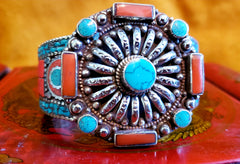What is Tibetan Jewelry?
Turquoise gemstones, rich cultural aesthetic, Buddhist Iconography? It must be Tibetan Jewelry! Tibetan Jewelry is influences by Indian culture, Chinese Culture and other Himalayan Cultures. Tibetan necklaces, bracelets, earrings, rings and pendants traditionally feature materials from across South Asia, East Asia and the Middle East. The symbols on Tibetan jewelry are usually from Himalayan Buddhism, but also may feature Hindu and Islamic iconography. The diversity that Tibetan Jewelry represents shows us the significance of Tibet historically, geographically, spiritually and politically.

The Historical background of Traditional Tibetan Jewelry
Traditional Tibetan Jewelry shows such diversity and styles and materials because of the historical importance of Tibet. Tibet is located between South Asia and East Asia, between East Asia and the Middle East. Merchants traveling between China and Europe would often pass through Tibet. So it is not uncommon to see traditional Chinese symbols such as dragons featured on Tibetan pendants. Coral is a revered substance in China, and so we can often see beads of Coral in Tibetan necklaces, chips of coral in Tibetan bracelets and Tibetan pendants. Tibet was a midway point between India and China, and the Indian influence in Tibetan jewelry is hard to miss. The very heart of Tibetan style is in essence that of the culture of North India. Across Northern India the cultural jewelry includes large necklaces, wide cuff bracelets and heavy earrings, bold styles of silver and gold. In fact, many of the traditional Tibetan jewelry artists would study in India and many traditional Indian artists would source their material from Tibet. Finally, we can see the clear influence from regions to the West in the types of Gemstones used. Perhaps the best example is Lapis Lazuli, a gemstone commonly featured in Tibetan Jewelry, which is almost entirely from Afghanistan.
The influence of Religion in Tibetan Jewelry.
Another major influence on Tibetan jewelry is religion. Historically the Himalayas was an amazingly diverse spiritual landscape. As Buddhism began in India and then flourished throughout South Asia, the religion traveled North through Tibet to reach China. Buddhism mixed with the diversity of religions in Tibet to form Vajrayana Buddhism, a very unique and visually rich form of Buddhism. Tibetan Jewelry therefore represents a from of Buddhism with features of ancient Indian Buddhism and East Asian Buddhism. Many Tibetan artists now live and work in Kathmandu Nepal, a Hindu region. And many Tibetan artists were closely connected with merchant communities that were Islamic. For these reasons Hindu and Islamic iconography and symbols are common in Tibetan Jewelry styles.
Tibetan Jewelry from Nepal
When discussing Tibetan jewelry we cannot ignore the geopolitical situation of Tibet today. Tibet was invaded by China in 1950 and since then Tibetan culture has been repressed in the Tibetan homeland. The Tibetan religious and political leaders fled to India and many merchants and artists fled to Nepal, India and other countries. Tibet does not export Tibetan jewelry today. Tibetan jewelry mostly comes from the Tibetan communities in Nepal, India and other countries. So Tibetan jewelry can also be called Nepali Jewelry, Himalayan Jewelry or even Buddhist jewelry.

Wear Tibetan Jewelry with Respect
Whatever style of Tibetan Jewelry you wear, it is important to take a moment to reflect on what the jewelry represents. The rich cultural heritage that is inherent in handmade Tibetan jewelry, the historical significance of the materials that were carefully crafted into that Tibetan pendant, necklace, bracelet or ring. It is important to remember that wearing a Tibetan cultural piece requires respecting the art and the culture that it represents by respecting the jewelry itself. An Image of the Buddha always deserves respect. A sacred mantra always deserves respect. Any work of art that has been carefully made by hand always deserves respect. By purchasing and respectfully wearing traditional Tibetan jewelry art you are representing and supporting the continuation of an ancient Himalayan art form and the expression of a culture. So go ahead, find a piece of Tibetan jewelry that you are drawn to. Dive into the history and significance. Wear it and enjoy It with respect. And know that you are now part of its story.
